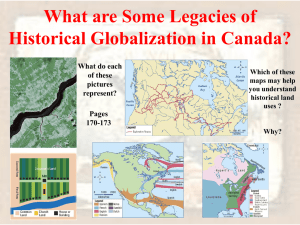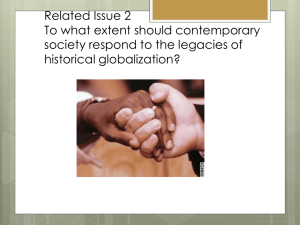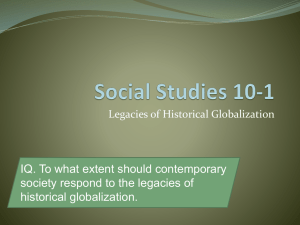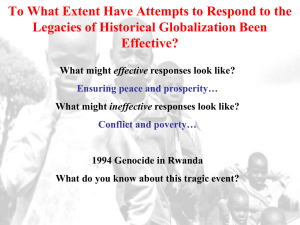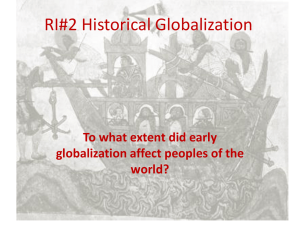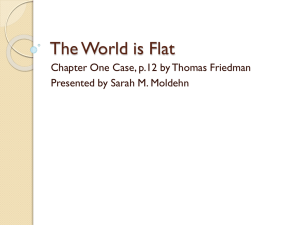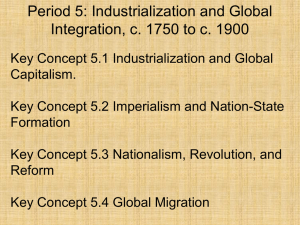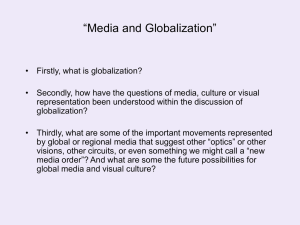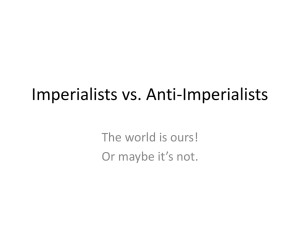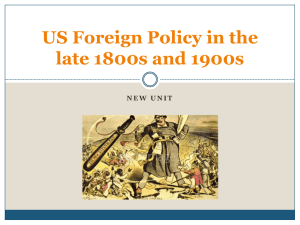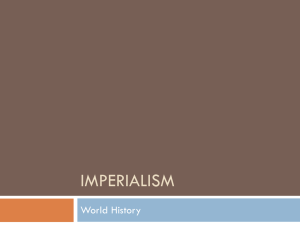Related Issue #2 - Chapter #6
advertisement
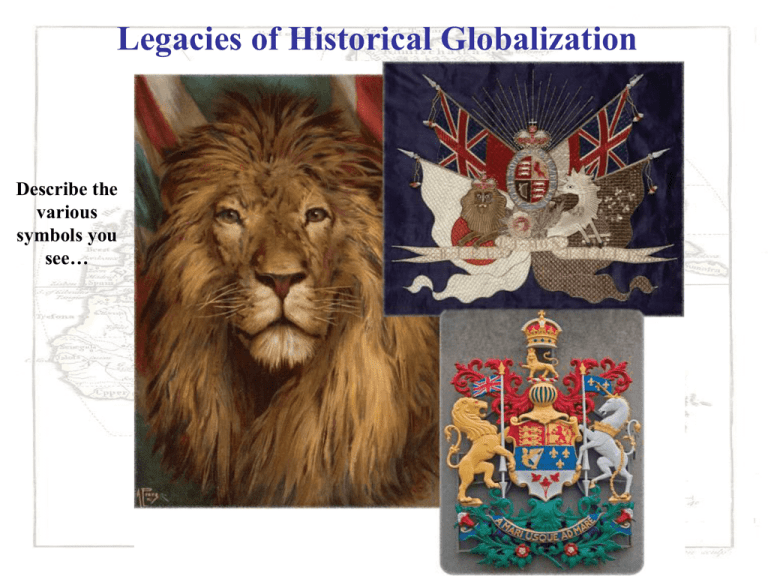
Legacies of Historical Globalization Describe the various symbols you see… To What Extent Do the Legacies of Historical Globalization Affect Peoples of the World? Read page 136-137, answering the six questions. List your responses in your notebook. Legacies of Historical Globalization Scan pages 136 – 141 and suggest ways that these pages reflect legacies of historical globalization… What language is being used in this textbook…? Most of the flags are from which continent…? What continent are the monarchs from…? Anything else? Is there anything in these pages that may not fit the ‘European’ view? What Are Some Legacies of Historical Globalization? Read the opening two paragraphs on page 138 Take a few minutes and think of some of the legacies that have been passed on to you What are they? Ethnocentrism and Eurocentrism Read the rest of page 138, including Voices What do these two terms mean? Read the handout: The Economy of Aboriginal Peoples at Contact After reading, create a list of the legacies and values found in the handout The Economy of Aboriginal Peoples at Contact Would a better understanding of the Aboriginal economy by the Europeans have changed their attitude towards them? Were the values of the Aboriginals compatible with the values of the Europeans? Are the values at all reconcilable or able to be brought together? There were two major periods of European Imperialism The first period occurred between the late 1400s and the beginning of the 1700s. This period saw mostly the establishment of colonies during pursuits of adventure in which explorers sought to get rich. Also, the desire to Christianize the world played a significant role. And, in addition, these colonies were a place to send excess, dissident, and/or persecuted groups. The Second Period of Imperialism By the middle of the 19th Century, Europe had undergone a phase of nationalism. The Industrial Revolution had been established in England and had begun to be adopted in other Western European states, and several ideologies had been adopted. In the second phase of imperialism the goals or reasons were economic, political, social/Humanitarian and technological. The aims of the imperial states were economic prestige (political), and strategic (military.) Mercantilism Colony Raw materials were sold to the mother country at a low price Finished goods were sold to colonies at a high price Mother Country Another aspect of this imperialism was its use of the economic practice of mercantilism. Under mercantilism colonies were useful as a captive market and a source of materials. In the economic exchanges that occurred the benefit was always for that of the mother country. Also, restrictions were placed on the colonies with regard to whom they could and could not trade with … Again to benefit the mother country. Reasons for Imperialism Social Darwinism End Pagan Rituals Desire for security “White Man’s Burden” Imperialism Slavery Need for advantageous trade after tariffs in Europe Desire for status and glory Need for raw materials Desire for diplomatic Bargaining chips Need for markets for surplus goods Building Empires Read the top of page 139 and complete the Activity Can you calculate the percent increases in both the land area and number of people during this time? The Scramble for Africa • What areas were the first to be colonized? Which ones were last? • Which imperial power controlled the largest area? Which ones controlled only small areas? • What geographic pattern does the French-controlled region show? What pattern does the Britishcontrolled show? What about the other European-controlled regions? • Which countries remained independent? Why do you suppose they were able to stay independent? The Scramble for Africa Read the first four paragraphs of page 140 Now, listen to the words of Mukunzo Kioko… Are you able to complete the Activity at the bottom of the page? King Leopold and the Congo Review the Handout: Legacies of Ethnocentric and Eurocentric Attitudes in Africa Read page 141 Fill in the ‘Evidence’ side of the chart as you read Keep this handout for future reference… Don’t lose it!! Evidence of Legacies in the Congo The European development of the slave trade Imperial powers’ policies of promoting mercantilism and global trade European (Eurocentric) attitudes that saw nothing wrong with conquering and ruling the Americas, Africa and Asia The Continuing Legacy in the Congo Today The effect of the slave trade on race relations around the globe today The global dominance of the European and American economies The willingness of some countries to interfere in the politics of other countries And Finally… Begin a list of terms from this chapter, which include… Any term or phrase that would be considered important in helping you with your … Four Corners Debate! Any suggestions as to what you should include? How Has Cultural Contact Affected People? Read page 144 Complete the Activity on page 144 With a partner, review the map by writing six questions about the map that can fit into the following three categories: People, Places and Things If time, pass your questions on to someone else to answer Legacies and Patterns of Historical Change Review the Handout: Analyzing Legacies of Historical Globalization Read pages 146 – 148 As you read, look for the main ideas and supporting information and jot down notes about these in the appropriate area of the handout Be sure to include a summary statement! Analyzing Legacies of Historical Globalization And Finally… Continue with your list of terms from this chapter, which include… Any term or phrase that would be considered important in helping you with your … Four Corners Debate! Any suggestions as to what you should include? To what extent did the causes of the imperial powers’ division of Africa affect the future of the Indigenous peoples of that continent? OR How did the splitting up of Africa (by many of the European countries) affect the future of the Indigenous peoples of that continent? Division of Africa… With a partner, complete the following cause and effect chart African Imperialism Assignment The Buffalo Point out former uses of the buffalo and describe items now used in their place How Has the Exchange of Goods and Technologies Affected People? Read page 149 Before and After the Horse Create a ‘T’ Chart like the one below Ways of Life Without Horses/Guns Ways of Life With Horses/Guns As you are filling this in, consider changes in transportation, hunting, communication with other groups and status symbols Contact and Cultural Exchange in India Review these two pictures and their captions on pages 150 -151 Who can summarize what you learned about the Silk Road? What do these two pictures have in common? Read all of page 150, including responding to the Activity and The Raj on page 151 Deindustrialization in India British Ban on Imports of Cloth from India Read the section on Deindustrialization in India on page 151, completing the chart How would you respond to the Activity? Mohandas Gandhi This photograph was taken in 1946, at a time when many in India were attempting to gain their independence from Great Britain Their independence came in 1947 Mohandas Gandhi “I want to save time and labour, not for a fraction of mankind, but for all. I want the concentration of wealth, not in the hands of a few, but in the hands of all.” What do you think the speaker is wanting? Read page 152 Now that you have read and know who the author is, what do you think Gandhi meant? Complete the Reflect and Respond on page 152 And Finally… Continue with your list of terms from this chapter, which include… Any term or phrase that would be considered important in helping you with your … Four Corners Debate! Any suggestions as to what you should include? This is a train station in India that was built as a replica of a similar station in Great Britain Can you see what the statue is at the top of the station? Queen Victoria – The Queen of Great Britain (and her colonies) for almost 40 years! Is this station a positive or negative legacy of historical globalization? How are the Legacies of Historical Globalization Continuing to Affect People? We have already discussed the some of the history of India and Africa… What do you know about India and Africa that would help you answer the question above? Read page 153, not including the Activity The Grosser the Better! What is GDP? Gross Domestic Product The measure of strength of a countries economy! The more the $$ the wealthier the country! Complete the Activity on page 153 Finally…Free from Great Britain!! Date of Independence from Britain Selected Countries Looking at this information and the GDP chart, discuss your responses to the Activity on page 153 Why are some of these countries ‘richer’ than some of the others? Legacies of British Imperialism in India While reading pages 156-157… Focus on how each of your points relate to a Legacy of Imperialism Record details about the Legacies of Imperialism in India And not on how many points you come up with!! Dividing up Alberta Let’s divide Alberta up into two! Where are we going to make the division? What groups should we talk to before we make this decision? Why? And Finally… Complete your list of terms from this chapter, which include… Any term or phrase that would be considered important in helping you with your … Four Corners Debate! Any suggestions as to what you should include? Think About Your Challenge Review your challenge for this Related Issue Contemporary society has done enough to respond to the legacies of historical globalization Remember to respond to the statement above with either: Agree, Disagree, Strongly Agree or Strongly Disagree Is there anything from this chapter (or chapter five) that you can add to your notes on Your Challenge? Only two more chapters remaining…. Social 10-1
